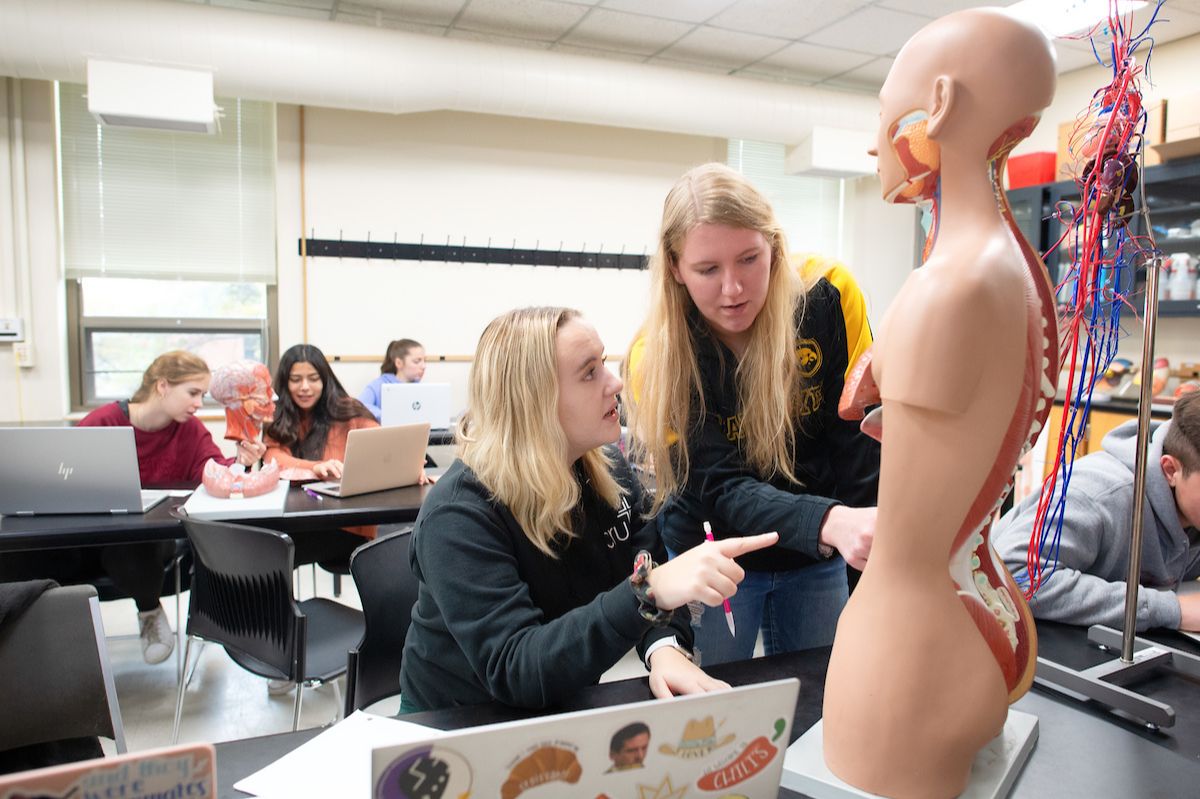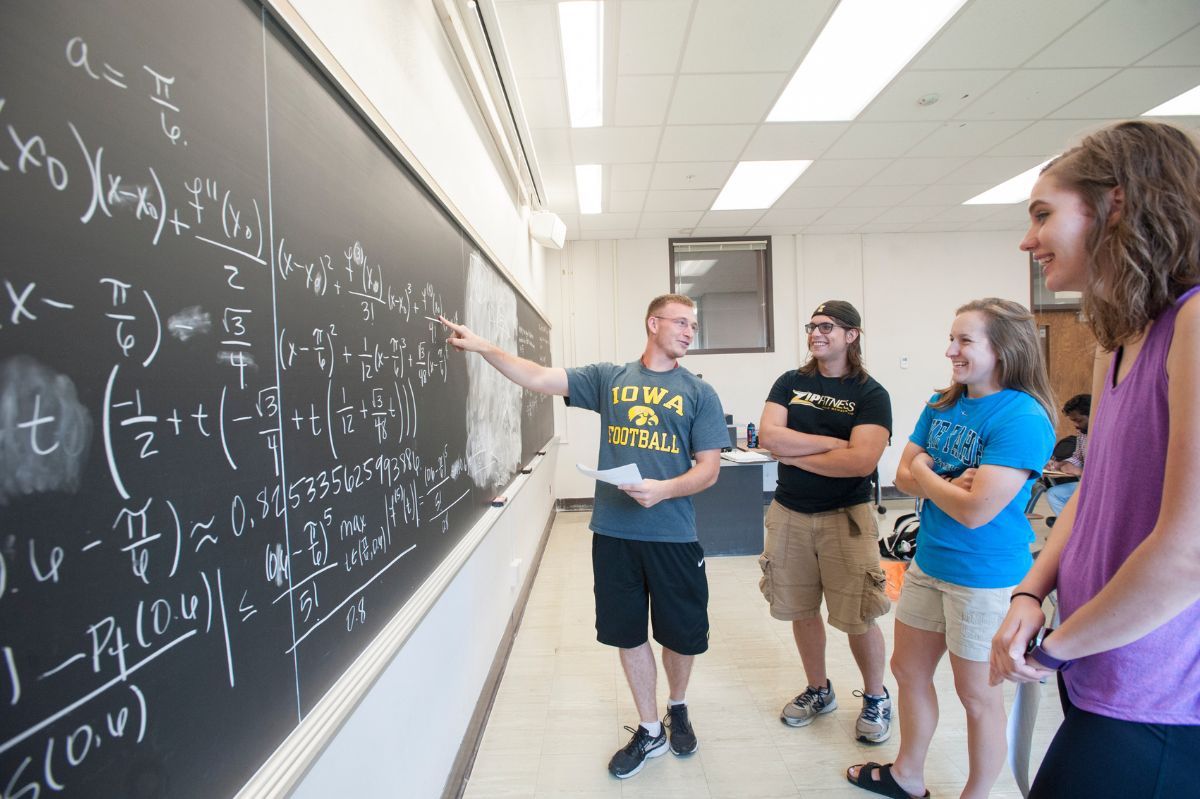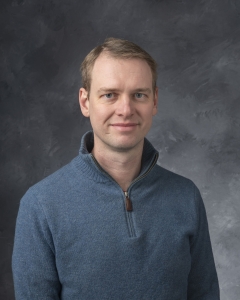By Izabela Zaluska
Faculty in six departments within the College of Liberal Arts and Sciences have redesigned their large-enrollment introductory STEM courses, taken primarily by first- and second-year students, to improve student experiences and learning outcomes.
The project is a collaboration between six departments and the college, as well as the university’s Office of Teaching, Learning, and Technology, Center for Teaching, Academic Support and Retention, and Office of the Provost.
The project aims to make sustained course improvements, especially for first-generation and underrepresented minority students. And the efforts are working — preliminary data suggests changes made in these courses are improving student outcomes.

A commitment to excellence in teaching
More than 11,000 students take these courses per academic year. The six CLAS departments include: biology, chemistry, computer science, health and human physiology, mathematics, and statistics. The project supports the university’s 2022-27 Strategic Plan goal of excellence in teaching and learning.
The P3-funded collaboration began as the Hawkeye Introductory Courses project, and the Excellence in Teaching and Learning project continues the work. In addition to continuous course improvement, there has been a focus on supporting faculty as they make curricular changes, improving graduate teaching assistant training, and including undergraduate students in the process.
“Another exciting aspect of this project is that the faculty involved in this effort have had the opportunity to attend and present at national meetings, such as the ‘Transforming STEM in Higher Education (AAC&U)’ conference,” said Cornelia Lang, associate dean for undergraduate education in the College of Liberal Arts and Sciences.
Lang, who, in her administrative role for undergraduate education, has been involved with advancing this initiative at UI, said these types of national meetings provide opportunities for Iowa faculty to meet colleagues from peer institutions who are also working on similar initiatives.
The project’s goal is to set students up for success not only in the introductory courses but also in the long-term during their academic career and beyond.
“Teaching and learning are always evolving, so it's nice that this program has helped provide us with those resources,” said Kelli Taeger, lecturer in the Department of Health and Human Physiology. “Student learning has changed, technology has changed, and this collaboration has helped us think about how we can change along with it and what we can do to present the best product possible for our students.”
Chemistry, mathematics, and health and human physiology are three examples of STEM departments whose students are benefiting from this project.
Adding learning assistants in the Department of Chemistry
One of the big changes in the introductory chemistry courses is incorporating learning assistants — supportive undergraduate peers who have already taken the course. The Learning Assistants Program is coordinated through the university’s Academic Support and Retention and implemented in partnership with the chemistry department.
Other changes included making learning objectives clearer for students and incorporating Gradescope, which allows faculty to give better feedback on discussion activities, exams, and other grades.
Having the learning assistants in class has been a positive experience for both students and faculty, said Renée Cole, professor and department executive officer of chemistry. Learning assistants have helped encourage engagement, normalize attending office hours, and give feedback on course changes.
“One of the things we have seen is the students who came in engaged with the learning assistants — and the course in general — that we reduced the DFW rates significantly,” Cole said. A “DFW” rate for a course is the percentage of students who receive a D or F grade or withdraw.
Students are shifting the way they’re engaging and thinking in the courses, Cole said. They’re talking about ideas and approaching issues the way scientists would.
Cole said the overall course feedback from faculty and students has been positive. She added how important the college’s support has been in getting these efforts underway.
“The college gave me space to create the resources for faculty, and having this community to help encourage and support has helped sustain this to build structure,” Cole said.
Cole, whose research focuses on improving teaching and learning environments in chemistry and other STEM subjects, said this project will positively impact many students and hopefully set them up for success beyond the course, including long-term success in the college and after graduation.
"This has been very much a team effort, and I do want to give kudos and credit to the faculty in the chemistry department,” Cole said. “The amount of work that all of them have put into this and continuing it on is remarkable.”
Rethinking exams in the Department of Mathematics
The curriculum changes for introductory math courses include adding test retakes, reformatting lectures to be more discussion-based, and revising course material to better prepare students for concurrent and downstream courses. The department also added Gradescope, an assessment tool used to provide timely feedback, to increase grading consistency.
"Exam retakes, I think, have been an important shift in philosophy to what assessment is, which is our goal in these classes,” said Ryan Kinser, associate professor and department executive officer of mathematics.
Introductory courses go beyond the content — students are also learning critical thinking skills and how to improve their learning, Kinser said.
Incorporating curriculum changes has been additional labor for faculty, and the support from the ETL team has been critical, Kinser said. The collaborative partnership part of this project has been essential in helping faculty think about different kinds of learning styles and long-term goals.
“It's really important for us to develop these high-quality introductory courses,” Kinser said. “Our faculty has the expertise in mathematics, and campus partners have the expertise in how students learn. This project has been really essential in bringing those resources to our department.”

Adding graded quizzes and anatomical models in the Department of Health and Human Physiology
The health and human physiology (HHP) department purchased anatomical models to help students study, while also including formative assessments in its curriculum changes.
Human anatomy, which is a required course for a variety of majors, was among the HHP courses that underwent redesign. Traditionally, the class included five exams that determined the final grade. Lecturer Kelli Taeger heard feedback from students asking for other grades.
“This project was a good time to really think about how I could make that change while maintaining the rigor of the course,” Taeger said.
Taeger also implemented frequent low-stakes quizzes where the lowest grade is dropped, as well as added language to the quizzes and other assignments explaining learning objectives. Students, on average, took the quizzes three times for additional practice.
Students are also using the anatomical models purchased by this project to study before exams, just as the department had hoped. The models are housed in the library for students to check out.
Taeger said she has received positive feedback from students, as well as support from other HHP faculty.
“We do want students to succeed, and we want to do what we can to help,” Taeger said. “It's nice to see that so many people are of that mindset, that we're willing to put in that as extra work if it will benefit the students.”
What’s next?
One of the main goals for the spring semester is to sustain and scale the course changes while ensuring faculty are set up for success.
For many of these courses, instructors change every few years. Project leaders are working with departments and DEOs to create plans so courses continue to improve as different instructors step in.
Faculty are also encouraged to learn from one another. Project leaders are connecting faculty from different departments to share ideas on innovative teaching methods and to get more familiar with courses students are taking concurrently.
Data and feedback from students and faculty is also being collected to understand the project’s impact and what changes need to be made looking toward fall 2024.
.jpg)

